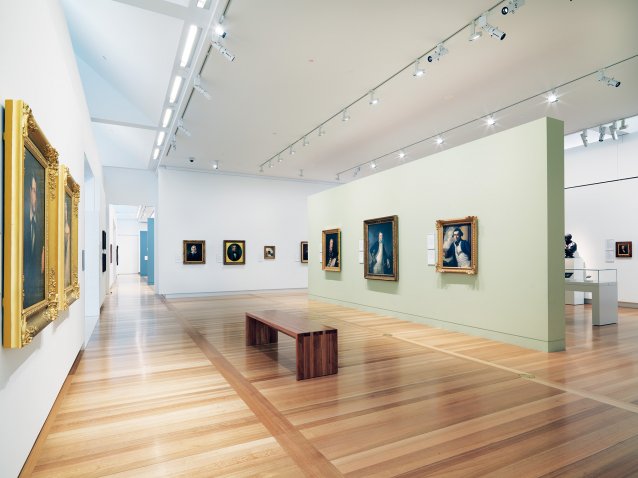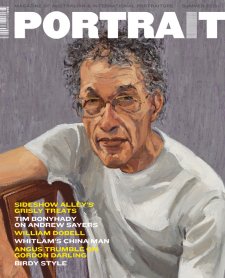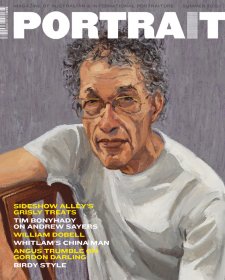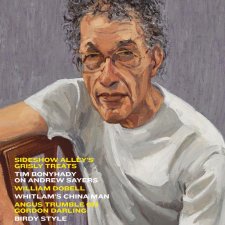Buildings tire when they are no longer cared for, either by those who use them, or by those whose responsibility it is to maintain them. On both counts, the National Portrait Gallery seems to me to be travelling well, and is in good care. First, it has accrued a substantial body of support from people who value the place as an integral part of our national cultural infrastructure, as well as an important part of Canberra’s local infrastructure. I don’t often visit Canberra now, but having spent most of my childhood and early adult life there, one of the aspects of the Portrait Gallery of which I am most proud is that it has become an integral part of daily life for locals, not least my 82 year-old aunt, who still circumnavigates the lake every week, with the obligatory pit stop at the Portrait Gallery Café. The experience of a place as a visitor is very different when you are aware that locals are there, too – they make the place authentic, alive, connected.
Secondly, and just as importantly, the building feels as though it is now finely tuned, having successfully passed the notional running in period. Whilst most modern cars, particularly those pushed off the production line, don’t seem to need much considerate attention in their first few months of use, buildings do need some time to settle in, and for their ‘drivers’ to become familiar with their idiosyncrasies and personality. This is not to suggest that the place is now predictable or unchanging. For me, one of the most fascinating aspects of the Gallery is that it retains elements of the original experience of the place from 2008, with new ways of working with the building to create fresh experiences and encounters with the portraits. This combination of (relatively) old and new suggests to me that the place is constantly being tested and tweaked to suit whatever the current requirements might be, but in a way that shows a commitment to working with the grain of the building, rather than against it.
Each of the temporary exhibitions I have seen has made me reflect on how the building has participated in the experience – sometimes openly, mostly discreetly. In every instance, the response has shown me, and I hope others, a different character to the place.
Having aligned the completion of every stage of my architectural education perfectly with a major downturn in the Australian economy, over several stints I managed to accumulate more than a decade of living in London. Life as a young graduate when work was tight didn’t afford much time off, but almost without fail I would visit the Tate Gallery in Millbank (now Tate Britain) every weekend to marvel at their unrivalled collection of J. M. W. Turner’s swirling, seething storms of colour and light. It was an easy visit from my digs in Putney, and whilst I was always captivated by the art, I was never completely satisfied – the building was tired, the galleries were drab, the coffee was awful.
Visiting Canberra is a very different experience, but my visits do run to the same pattern – I always visit the Portrait Gallery, and as browsing has never really been my thing, I always seek out certain works, hoping they are on display. But my first stop is always the sofa in the Gordon Darling Hall, preferably one facing west. Five minutes there, surveying the movements of whoever is about, brings me a great sense of calm and refreshment. It is the perfect place from which to survey the life of the place, and gauge the mood. Not too noisy, not too quiet; every aspect of the place can be experienced from this central strategic position. Having recharged, I check the flowers, which are not just a decorative flourish but an important orientation device that was mentioned obliquely in the competition brief, and which for us become an important emblem for the character of the place. Set in the beautiful vessel made by Johannes Kuhnen, and different on every visit, they are the pivot for the entrance into the galleries, and a foreground to moving into that part of the building, not part of the background.
Then I’m off, looking for three favourites in particular, and anything and everything in between. First, Webber’s portrait of Cook, then Chrissy Amphlett by Ivan Durrant, and then Paula Dawson’s portrait of Graeme Murphy. Why these? Well, that’s another story, but they do illustrate the extraordinary diversity of the Gallery’s collections, and how each works with the building in a different way. Combined with a coffee, and without wanting to sound vainglorious, my visits to the National Portrait Gallery, short and sharp or long and luxurious (if a meeting finishes early or a plane is delayed), feel uplifting and complete – after another five minutes on the sofa, I leave refreshed, satisfied, but also wanting more of the place, not just the collection – a complete experience very different from those earlier visits to the Tate.
Thinking of those three favourite pieces now, it strikes me that it is the people and personalities who I encountered, and who made the National Portrait Gallery a reality, that are reflected in the building and my personal experience of the place, and refresh my experience on every visit.
Some are universal yet intimate, like Richard Johnson’s shoulder line discreetly marked on the rounded edges of each of the gallery thresholds, or Andrew Sayers’ considered pacing of the gallery layouts, which were worked through with him in a series of discussions and working sessions in our Sydney studio.
Having just learned, at time of writing, of Andrew’s passing after his courageous battle with pancreatic cancer, it is important to acknowledge his significant influence on every aspect of the National Portrait Gallery. His input and vision, from strategic planning and operational issues, policy and governance matters, to details of space, light, materials and finishes, was instrumental in defining the essence of the place. Andrew’s optimism, and his care for the institution, the portraits and the visitor, inspired us and everyone involved in the delivery of the project, and his influence will be an enduring one.
Other memorable experiences refer specifically to moments in the building’s construction that were humorous and horrendous, generally in equal measure, like the time when one of our project architects, quite late in the construction phase when time pressures were at their peak and everyone was stressed as the opening day neared, prepared a site observation report noting a major structural crack in the entrance hall. Horrifying at first, it quickly became evident through reading the notes that it was a report on a crack of a rather more temporary nature – ‘builder’s crack’, inadvertently encountered when trying to document the installation of some ceiling panels – so readily fixable with no long-term implications for the building! Thankfully, everyone, including the contractors, saw the funny side, and it served a very useful purpose to defray the collective nerves for another week or so, and get everyone to focus on the main objective – complete the building, and do it as well as we could collectively manage.
Moving through the collection, I am sure others will recall their own connections with friends, relatives, personalities, moments which link them to others or other events that are significant in their own lives. Those encounters with the portraits are what make the National Portrait Gallery so powerful and so broad ranging in appeal.
I’m not sure this constitutes a ‘portrait of a building’ and it is probably not at all what the director was hoping for – the editor may need to find something a little racier to pique the interest of Portrait’s readers! It is only my portrait of the place, which I recolour a little every time I visit, adding something, filling in a gap here and there, scratching out something else. All this investment is not to improve the design, or make the building better, but to measure my experience against those earliest design ideas we sketched out a decade ago.
My portrait of the building is always taken from the viewpoint of that sofa in the Gordon Darling Hall, where it is possible to take stock of the formalities which mark the place as a national institution of international repute, as well as the informal bustle of the staff and visitors, comfortable in a setting which exudes excellence and confidence in the future. That seat is also overlooked by Jiawei Shen’s luminous portrait of Gordon Darling, the Gallery’s founding patron, who has just recently passed away; and it is where I most vividly recall the gravity of Gordon’s influence on the project – like that mysterious force, it was ever-present, always drawing us towards excellence, quietly forceful, unifying and ultimately indelible on every aspect of the place.















